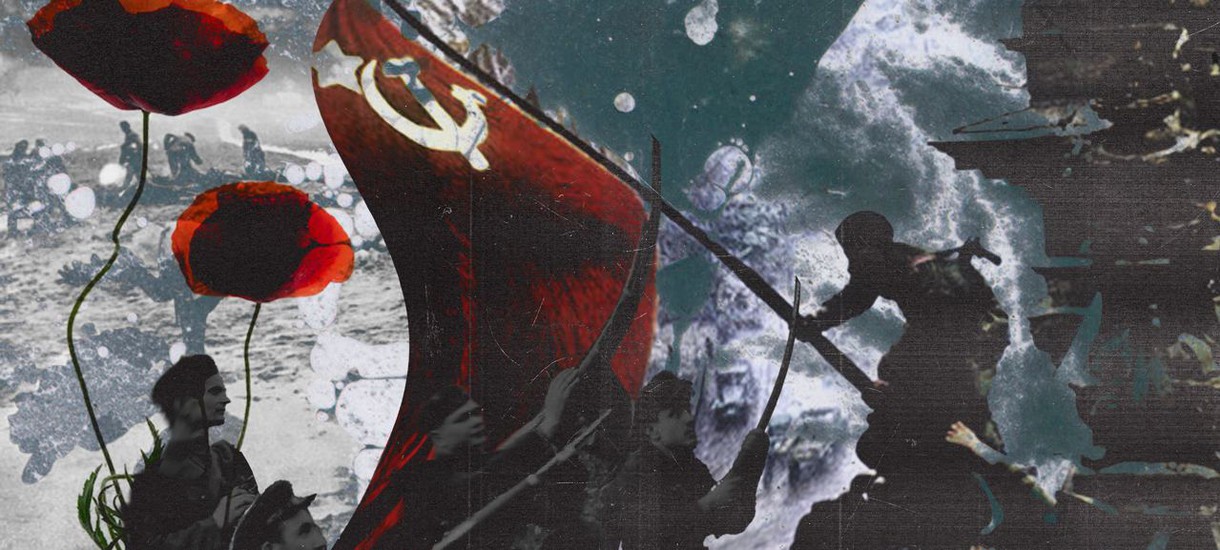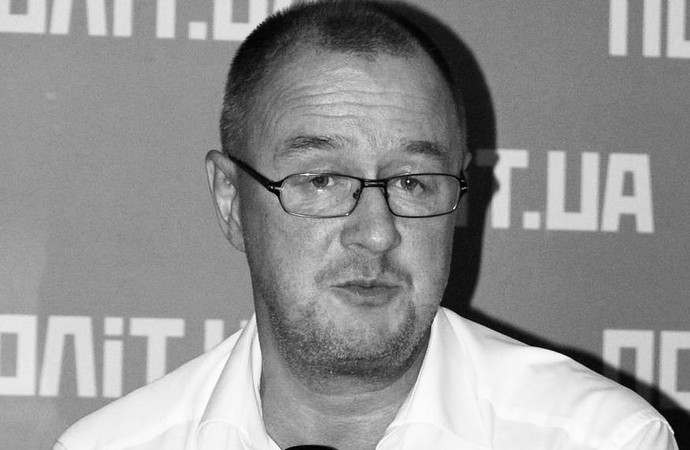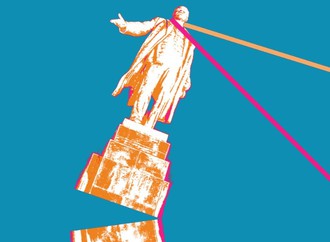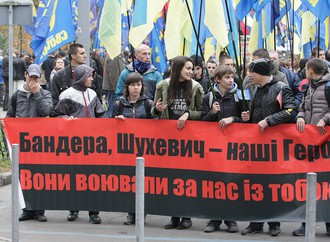Since Ukraine's declaration of independence, there have been shifts in various policies concerning the observance of May 9, whether as Victory Day or Memorial Day. How was Victory Day marked during the tenures of the first two presidents, Leonid Kravchuk and Leonid Kuchma? Was there ongoing discourse regarding the commemoration and celebration of this occasion?
In the 1990s and even the early 2000s, there were no deliberations specifically about the date itself. However, during that period, a certain segment of society harbored criticism toward this date. This segment is often referred to as party nationalists, aligning with nationalist parties. Nonetheless, society as a whole maintained a favorable outlook toward May 9.
The discourse surrounding the holiday only emerged when attempts were made to amalgamate the Soviet narrative of victory with the already-established myth of the Organization of Ukrainian Nationalists (OUN) and the Ukrainian Insurgent Army (UPA). In 1995, in commemoration of the victory anniversary, a proposal surfaced for an order that fused Soviet symbols with those of the OUN and UPA. For instance, the ribbons typically affixed to the award were red and black. However, this proposal was ultimately quashed by veterans of the Soviet army.
Until the early 2010s, Victory Day remained a relatively uncontentious holiday, receiving largely positive acceptance from the majority of society. It retained its Soviet-era tradition, which was even further reinforced by authorities in 2000 when Kuchma issued a special decree regarding the celebration of Victory Day over Fascism. This decree introduced a range of ceremonial practices, entirely Soviet in nature, such as the establishment of "glory corners" in schools. Interestingly, these corners were later transformed into Holodomor corners. Despite their Soviet origins, these rituals were embraced as part of official commemorations and were generally viewed positively in society.
The conflicts began to emerge in the early 2010s, initially surfacing in Western Ukraine. Around that time, in 2011, the Verkhovna Rada passed another law known as "On the Flag of Victory." This legislation mirrored Russian law, enshrining the so-called "Victory Banner," the flag of the 150th Rifle Division of the Red Army, which was hoisted atop the Reichstag building on May 2, 1945. During Viktor Yanukovych's presidency, there was a concerted effort to promote a neo-Soviet narrative in the commemoration of World War II, with attempts to introduce this Victory Banner as a national symbol.
Simultaneously, the "Party of Regions" and the Communist Party of Ukraine actively exploited the topic of "Ukrainian nationalism," particularly in the context of the OUN's collaboration with the Nazis. They blended the neo-Soviet myth of the Great Victory with the Soviet portrayal of the OUN as perpetual Nazi collaborators, thereby politicizing historical narratives to discredit political opponents as nationalist successors of collaborators. The law mandating the display of a red flag alongside the state flag on Victory Day sparked significant controversy. Individuals like representatives of the Rodina party then ventured to Western Ukraine, specifically to Lviv, where they prominently displayed this flag, with clear intentions. Conversely, Svoboda and other right-wing radical parties willingly engaged in conflicts over this symbol, sometimes leading to physical altercations. This pattern persisted until around 2013, with clashes regularly erupting around the "Victory Banner" in Western Ukraine. Later, under Yanukovych's administration, the Constitutional Court annulled this law. Nonetheless, as a political maneuver aimed at diverting attention from pressing issues such as corruption and rising prices, it proved effective.

The Victory flag and the Z symbol displayed on a Russian military vehicle in Kazan. Photo: Wikimedia
Nevertheless, society maintained a positive outlook towards Victory Day. The holiday consistently ranked among the top five most celebrated, alongside Christmas, Easter, New Year's, and March 8. In 2015, as part of the "decommunization package," the law "On Commemorating Victory over Nazism" was enacted. Unlike the 2000 law, which emphasized victory in the Great Patriotic War, this law focused on victory in the Second World War. Concurrently, two commemorative dates were introduced: May 8 and May 9. According to the law's proponents, May 9 retained its status as Victory Day, while May 8 was designated as the Day of Remembrance, aligning with a European standard. Symbolically, the legislation introduced the poppy flower, borrowed from the symbols of the First World War's Poppy Day. This move aimed to emulate the "European" observance of May 8, receiving a somewhat favorable response from a segment of society. Public opinion polls revealed that, although not a majority, there were individuals supportive of the idea of observing May 8 instead of May 9. Traditionally, Western Ukraine leaned slightly towards May 8, while Central, Eastern, and Southern Ukraine favored May 9. Nonetheless, despite official initiatives, May 9 remained popular until 2022.
The year 2022 brought about radical changes. Now, approximately 13% of the population considers May 9 an important holiday, with most residing in the Kyiv-controlled territories of Central and Eastern Ukraine. In a certain sense, the Soviet history of this symbol, May 9, ends in Ukraine. Victory Day, once a part of the invented Soviet tradition, gradually faded over 30 years, losing its original meaning. However, Russian aggression and the war against Ukraine played a decisive role. I think that the primary opponent of May 9 in Ukraine was Putin, who utilized the same Soviet myth of the great victory as an ideological component for war against Ukraine, framing it as unfinished business from 1945.
Can the initial confrontations be linked not to Viktor Yushchenko's presidency but to Yanukovych's, when the consensus established under the first two presidents began to shift?
Yushchenko attempted to reconcile two myths: nationalist and Soviet. He proposed the joint celebration of Victory Day with veterans of the Ukrainian Insurgent Army and veterans of the Soviet Army. While noble in essence, this idea faced significant hurdles, primarily due to the stance of Soviet veterans. An anecdote illustrates this friction: during an official celebration of Victory Day, a Soviet veteran addressed UPA veterans as "Dear Ukrainian-German nationalists," echoing the ideological rhetoric of the late 1940s and early 1950s when UPA soldiers were officially labeled as such.

Viktor Yushchenko with veterans during a celebration on May 9, 2007. Photo: UP
During Yushchenko's presidency, tensions arose, not specifically related to May 9, but rather concerning the elevation of the nationalist narrative surrounding the OUN-UPA to a national level. In October 2005, clashes erupted in Kyiv during a march honoring the UPA. On October 14, opposing groups dispersed: nationalists congregated in one area while left-leaning factions — comprising the Communist Party of Ukraine and the Progressive Socialist Party of Ukraine (both banned in 2022 for their anti-Ukrainian stance, - ed.) — gathered elsewhere. And how exactly are they leftist? Certainly, this appears to be merely symbolic: the so-called "left" parties were actually funded by big capital. Notably, there were no significant conflicts directly tied to May 9 during Yushchenko's tenure. Instead, efforts were made to diversify the holiday and foster reconciliation among individuals who had fought against each other during the period of 1944-1947.
In 2015, an endeavor to blend different commemorations emerged, coinciding with the passage of legislation. This initiative sought to merge the May 9 Victory Day observance with new forms of remembrance associated with the war in eastern Ukraine. Several videos featuring characters reminiscent of heroes from Soviet war films were released. One such video depicted a military general, a Soviet retiree, portrayed by an actor from the film "Only ‘Old Men’ Are Going Into Battle," being greeted by an officer from the ATO (Anti-Terrorist Operation; an official term for Donbas war in 2014-2018, - ed.) on May 9. Additionally, there was a proposal to inter an unknown ATO soldier at the Tomb of the Unknown Soldier in Kyiv. However, this proposal sparked controversy and did not garner societal support. In his May 9 address, then-president Petro Poroshenko referenced Ukraine's ongoing war to Patriotic War, appealing directly to Soviet tradition. While this attempt was made, it was short-lived and ultimately followed the trajectory of embracing and propagating the nationalist narrative of the OUN and UPA as central themes of Ukraine's participation in the Second World War.
You brought up various practices instituted by the central government. But were there local variations in how people observed this holiday? Were there any conflicts at the local level?
There existed a standard mode of commemoration dating back to Soviet times. The presence of the monuments to soldier-liberators was ubiquitous, found in tens of thousands of settlements, and many still stand today. Over time, this portrayal of the soldier who made the ultimate sacrifice for their homeland began shedding its Soviet ideological connotations. In some villages, for instance, the monument took on a more localized significance, serving as a tribute to villagers who perished in the war. Consequently, it's pertinent to discuss grassroots commemorations, wherein individuals had their own rationale for how and why they marked certain dates associated with the war.
In addition to Victory Day, there were several other official dates linked to the war, such as June 22, marking the war's onset, the Day of Remembrance and Mourning, and October 28, commemorating Ukraine's liberation from German-fascist occupiers, and subsequently, from the Nazis. These dates also held significance in the public consciousness and official memory politics.
When discussing regional observances that significantly diverged from the national norms of commemoration, it's notable that in Eastern Ukraine, particularly in Donbas, Soviet-era traditions persisted. For instance, the cult of the Young Guard was upheld, complete with its own museum and commemorative events. Similarly, in Odesa, there's the renowned Wall of Heroes of the Soviet Union near the opera house. Generally, the Soviet-style collective memory was more prevalent at the grassroots level in Central-Eastern and Southern Ukraine. Conversely, in Western Ukraine, the Soviet paradigm of wartime remembrance waned, although remnants such as monuments still existed, and local Soviet veterans often congregated on May 9.

Monument to Young Guard members in Krasnodon, Luhansk region, June 22, 2011. Photo: Andriy Kuznetsov / RadioSvoboda.Org
A crucial aspect to underscore is that May 9 emerged as an invented tradition within the collective consciousness of society, independent of official endorsement. People genuinely celebrated May 9 with sincerity. Equally significant is the positive nature of this commemoration, centered around the triumph of victory. While acknowledging the elements of suffering and victimhood inherent in wartime experiences, the overarching sentiment of the cult remained affirmative — a recognition of prevailing in the most devastating war of the 20th century. This positive ethos continues to serve as a cornerstone of the May 9 commemorative tradition, albeit often unconscious.
Examining this issue within the context of international relations, it's essential to consider the influence of global practices on Ukraine. In Central Europe, historical perspectives and attitudes toward World War II have been reevaluated. Meanwhile, Russia has introduced distinctive commemorative practices for May 9, such as the Immortal Regiment movement. How have these developments impacted processes within Ukraine and exacerbated tensions surrounding May 9?
Certainly. Regarding Russia, the St. George ribbon warrants mention. Initially popularized in Russia in 2005, this symbol gained significant traction in Ukraine, particularly in regions like the South, East, and possibly Central Ukraine. However, by 2017, the St. George ribbon had become associated with separatist movements, prompting Ukraine to enact a law banning its display. This shift occurred as the ribbon was increasingly used as a symbol of Donbas separatists, particularly since 2014 when it became linked to the narrative of resistance against the "Kyiv junta" and "Kyiv punishers." Consequently, once widely embraced in Ukraine, the St. George ribbon has since acquired toxic connotations, leading to its prohibition through special legislation carrying administrative penalties.
Over the past two decades, Ukraine has increasingly found itself within the orbit of Eastern European memory politics. Initially, Ukraine looked to it for inspiration and guidance. It was particularly evident in the establishment of the Ukrainian Institute of National Memory, which closely mirrored similar institution in Poland. Ukrainian initiators sought to replicate these models — consistently, albeit unsuccessfully. Meanwhile, in Central and Eastern Europe, there was a notable shift in the perception of the Red Army from liberator to occupier. This transformation gave rise to the concept of "double occupation" and "double genocide," referring to both Nazi and Soviet regimes. This narrative posed a significant challenge for Russia, as the Soviet myth of the Great Victory and the role of the Red Army were central to its official identity policy. Consequently, tensions emerged. First, representatives from certain Baltic countries opted not to participate in commemorative events on May 9, 2005. The situation escalated further in 2007 with the controversial relocation of the Soviet monument to the unknown soldier in Tallinn, Estonia, from its original location in the city center to a peripheral area.
Ukraine notably leaned towards the Eastern European model, particularly after 2014 when Russia's actions served as a catalyst, marked by the annexation of Crimea and the onset of a hybrid war characterized by the cult of victory, often criticized as "pobedobesie" (victorymania, - ed.). From 2015 onward, Ukraine's memory politics increasingly embraced the concept of double occupation, with the beginning of the occupation pushed back to 1920-1921. Even some textbooks already have it all! This narrative suggests that with the establishment of the Ukrainian Socialist Soviet Republic and particularly after the Treaty of Riga, Ukraine fell under occupation. Although not yet enshrined in specific legislation, this narrative is actively promoted at the ideological level. Thus, while Central and Eastern Europe typically pinpoint the start of occupation to 1945, Ukraine's narrative places it earlier, in 1920-1921 or even 1917. The idea that the Red Army, while ostensibly liberating Ukraine from Nazi occupation, also ushered in Soviet occupation, is becoming more and more popular, representing a significant ideological departure from previous historical perspectives.
Did the politicization of Soviet symbols linked to World War II in Ukraine influence other former Soviet Union countries? While you mentioned the Baltic countries, what about the South Caucasus or Moldova, our neighboring country?
I haven't delved into this area specifically, so I can't provide detailed insights. However, I'm aware of certain initiatives in Poland following our decommunization laws. The Poles also attempted to impose restrictions on the use of communist symbols. Similar efforts were made in the Baltic countries and some Central-Eastern European and Balkan nations (such as Romania) even before 2015. Overall, Ukraine's influence on others in this regard seems limited compared to the influence exerted on Ukraine by its neighbors. Particularly during the active phase of decommunization from 2015 onwards, Ukraine largely followed the practices observed in Central and Eastern Europe. Regarding the post-Soviet space, except for the Baltic states, the Soviet narrative of May 9 persists in most areas.

The Latvian Seimas urgently adopted the law "On the prohibition of certain public events on May 9", prohibiting any events except those related to Europe Day. The photo shows posters at a rally in Riga. Image: AFP
In the realm of memory politics, what role do historians play? In "Danse Macabre," you discuss Stanislav Kulchytsky's involvement in shaping the Holodomor memory policy alongside politicians and public organizations. Have there been historians with similar influence in shaping the remembrance of May 9? How do we evaluate the broader role of historians? Were they merely serving political agendas, or did they have their own agency?
The dynamic with the historians is intricate. Historians shape discourse and disseminate it, but they are not independent creators; they are influenced by societal currents. For instance, historians have attempted various approaches to merge the Soviet narrative of a great victory with Ukraine's portrayal as a victim of two totalitarian regimes. Initially centered around the Great Patriotic War until 2000, this narrative naturally expanded to encompass the broader scope of the Second World War. Subsequently, historians endeavored to integrate some form of European commemoration with the Soviet narrative, embedding the latter within the former. This dynamic is complex because historians are individuals shaped by public sentiment. Not to mention that they are not immune to the impact of state policy. Nonetheless, they can exert influence on policy themselves. Historians craft discourse, which is then either embraced or rejected by society, as well as by segments of the government.
When historians witness their discourse taking hold in society and functioning effectively, they may perceive it as evidence of its naturalness and correctness. You have mentioned Holodomor; public opinion shifted from 60% and 70% to 92% considering it genocide over time. Historians might interpret this trend as validation of the discourse's accuracy due to its widespread acceptance. However, such historians risk error if they equate societal acceptance with historical truth. Similarly, with May 9, public opinion polls have indicated it as the most popular holiday, it's worth noting that these were quantitative surveys, not qualitative studies. The findings from focus groups might reveal a different perspective altogether. Therefore, historians supposedly have to analyze these processes, yet they are also part of them. And their role in these processes, of course, has been significant.
However, it's important to note: who exactly do we consider historians? Ann Applebaum, for instance, is a journalist with an "incomplete historian’s education" but is often referred to as a historian. Although she authored a book about the Holodomor, she did not show much interest in the topic before or after that book. She wrote a book (with material gathered by Ukrainian historians) and suddenly became recognized as a historian of the Holodomor. So, who qualifies as a historian? Are they the hosts of television or YouTube programs? Are they the creators of YouTube channels? The distinction lies in the fact that there are popular historians who may simply convey certain ideas without being rigorous researchers, whereas there are those who are dedicated researchers. Therefore, if historians regard history as a profession, they might not necessarily influence the process of changing the politics of memory and social narratives.
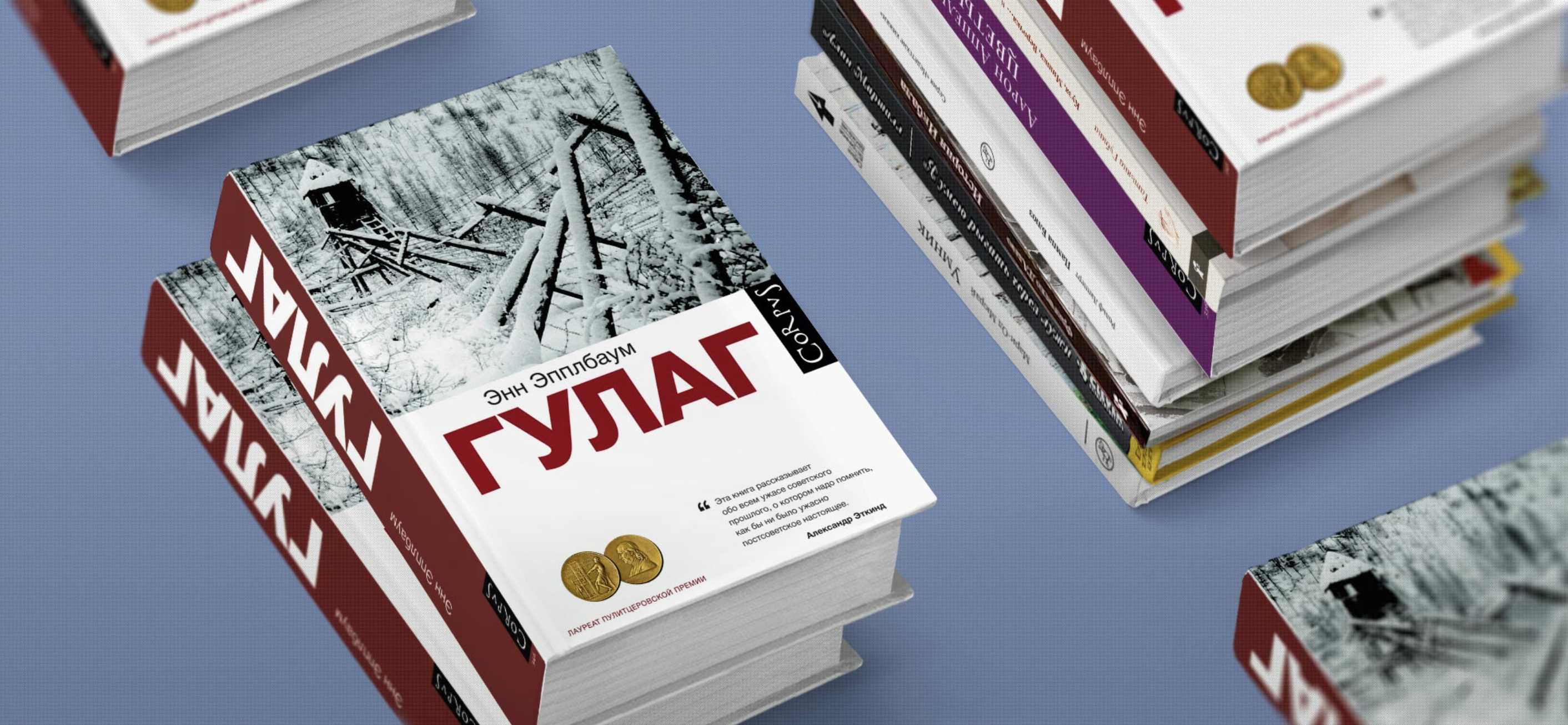
Journalist Ann Applebaum's book "Gulag"
There are political historians who engage with historical politics not by researching it, but rather by shaping it. In this realm, certain historians have played notable roles, such as Volodymyr Viatrovych and his group. Viatrovych embodies a distinct ideological force, a political force — OUN-Banderites. In this context, Viatrovych fulfilled his ideological and political role. His function was clear: to dismantle the Soviet historical narrative and instead advocate for the Ukrainian nationalist perspective. It's simple.
So, he and a whole group of individuals, having gained access to the central body of executive power responsible for historical policy — the Ukrainian Institute of National Memory — leveraged this resource to its fullest extent. It's still premature to determine the full extent of their success. However, it's evident that they achieved at least partial success, particularly in countering the Soviet myth of the great victory. Putin's actions furthered this cause by transforming the myth into an ideology of aggressive war. Thus, historians wield significant influence, but they are not the kind found in analytical historiography. Instead, they operate within the realms of affirmative, ideological, and didactic historiography — fields of history connected to practical historical politics and serving political groups and ideologies.
You mentioned that in post-Maidan Ukraine after 2014, May 9 was still regarded as a holiday, despite varying policies from the central government. If there hadn't been Russia’s full-scale invasion in 2022, how stable would this situation have been? On one side, people continued to celebrate May 9 as a victory, while on the other, there existed an official policy, creating a gap between the two. Could this arrangement have endured, or would one position eventually dominate? How would you assess this scenario?
One position eventually prevailed: the Soviet interpretation of this holiday began to fade. Like any myth, it gradually diminishes over time — nothing remains eternal. Similar dynamics unfolded here: initially, the elements of Soviet fervor began to recede from the narrative, giving way to an understanding of the war as a tragic event with a significant loss of life. This process didn't commence in 2014 but had been underway for much longer. As I mentioned earlier, there were alternative dates associated with Ukraine's liberation and the victory over Nazism.
It's crucial to grasp that in Russia, the cult of victory underwent a transformation from a commemoration of tragedy and triumph to a militaristic cult, taking on aggressive undertones. The phrase "we can repeat it" starkly embodies the essence of this cult. Initially dubbed as a "pobedobesie," ironically, it indeed manifested in this manner eventually. We live in the information age, and when people witnessed how this cult manifested in Russia, even those who previously held a benign view of the May 9 holiday gradually developed a more cautious stance toward certain aspects of that cult, which began to resemble something sinister.
Another aspect is attributing the victory solely to Russia as if it were exclusively their accomplishment. In 2010, Putin remarked that he could have managed without Ukraine. It's crucial to remember that Ukraine endured complete occupation and later achieved full liberation. The nation suffered immense human and material losses, enduring unimaginable hardships during the war. Therefore, simply dismissing the significance of this holiday for Ukraine by stating "it's not our holiday" and focusing on our own heroes is detrimental, as it allows Russia to monopolize the entire narrative. This is exactly what happened, leading to the emergence of troubling phenomena like the Z-cult. However, circling back to your question, the Soviet elements of the May 9 holiday gradually faded in Ukraine, while universal themes gained prominence.

A billboard on Ligovsky Prospekt in St. Petersburg, March 7, 2022. Photo: EPA / Scanpix / LETA
What followed — the decline in the number of people regarding May 9 as a holiday — is not solely attributable to ideological factors, aggression, and the vindication of this aggression through the cult of victory. In reality, there were other contributing factors. Russia's occupation of territories in Ukraine, which were more inclined towards the traditional May 9 cult, played a significant role. Consequently, the number of proponents of these views in the Kyiv-controlled territories dwindled. Therefore, external factors that become internal for us also wield significant influence: as the population decreases, so does the number of proponents and supporters of the Soviet cult.
You have aptly outlined how Russia's military cult of victory justifies its invasion, further alienating the Ukrainian population. However, might this also propel Ukraine towards greater glorification of the UPA and nationalists? Perhaps the cult championed by nationalists under Vatrovych's leadership will gain even more traction during the war. Historical parallels are widely popular. Russia often draws parallels likening itself to the USSR during World War II, so it's conceivable that the notion of Ukraine aligning with the UPA could become increasingly acceptable to the Ukrainian populace. Is there a limit to this progression, or will there be a complete shift from honoring the heroes of the Red Army to venerating those of the UPA?
It's premature to draw conclusions due to the lack of data. An extensive array of diverse sources is necessary for comparison before any preliminary assessments can be made. Up until 2018, there was a noticeable upsurge in the cult of the UPA and OUN, with a growing proportion of respondents expressing a positive sentiment towards them. However, the realm of sociology is quite intricate. Consider how the question is framed: "Do you consider the members of the OUN and the soldiers of the UPA to be fighters for the independence of Ukraine?" It's akin to asking whether Malevich's Black Square is indeed a square. And what were they fighting for? They were fighting for independence — albeit in their own manner, employing their own methods, with many exhibiting sacrificial commitment. You can't phrase a question like, "Could you please confirm if two multiplied by two equals four? Or does anyone suggest otherwise?" Moreover, a law was enacted mandating that the OUN and the UPA be treated unequivocally as fighters for independence. While the proponents of the law may disavow any binding nature, in fact, it is true. And it implies that individuals who criticize the OUN and the UPA are engaging in illegal activity. If such a law exists, consider trying to answer negatively whether they were fighters for independence, especially during a phone interview when your identity is known.
In this context, the positive sentiment towards the OUN and the UPA initially grew, then stabilized at a certain level, as evident from surveys. However, after 2022, there was a sharp resurgence observed. It's worth noting that Ukraine has lost control of some of its territories, making it impossible and futile to conduct interviews in those occupied regions. The territories that showed the most resistance to the myth of the OUN and UPA are now occupied. Once again, Putin played a significant role as a major decommunizer by physically destroying these territories and depopulating them. Additionally, there are ideological factors within the country contributing to this trend. Indeed, the UPA and the OUN, during a certain period, were openly and distinctly anti-Russian and anti-imperialist. This aspect should not be overlooked. Consequently, their views and practices directed against Russia align organically with the modern context, especially as Russia espouses a neo-imperial aggressive ideology. However, there were other ideological components within the OUN, such as the program of establishing a one-party totalitarian state, xenophobia, the promotion and practice of ethnic cleansing, and the denial of political pluralism. These aspects are often omitted in propaganda efforts, which is understandable given the nature of propaganda.
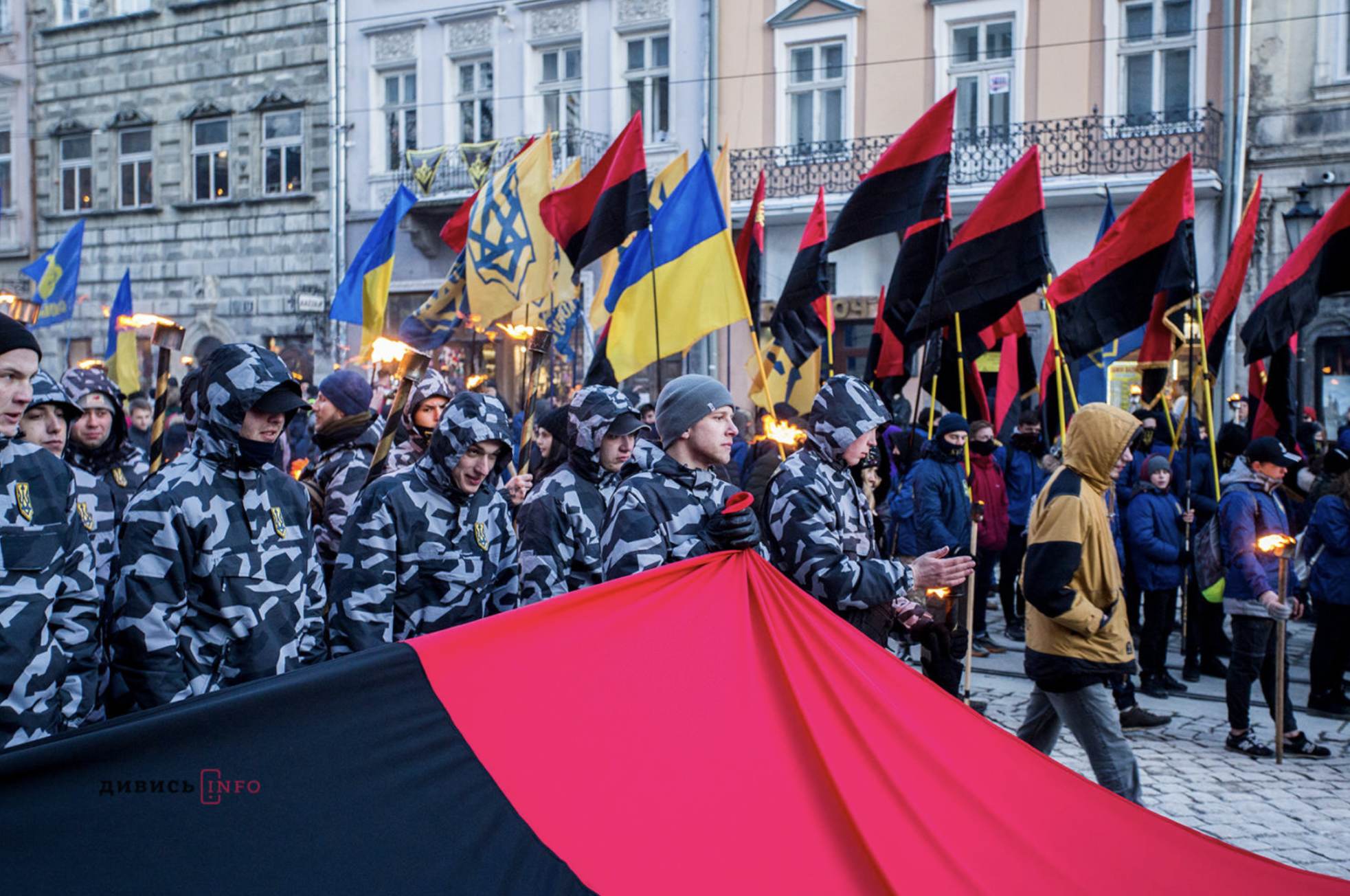
Commemoration of Roman Shukhevych, OUN leader, by nationalists in Lviv, 2018. Photo: from open sources
In conclusion, what forms of remembrance characterize May 8-9 presently? And how would you describe the different opinions in this uncertain situation?
Take into account that May 9 is no longer a public holiday — it's now May 8, Memorial Day. Personally, I find this reformatting appealing. But let's revisit the idea that we've essentially handed over the symbolic victory capital to Putin, allowing him to use it to justify aggression against Ukraine. It seems counterintuitive. While it may be too late now, we should have reclaimed this victory narrative. We should have emphasized that victory came at a tremendous cost. The key takeaway from such a victory is that war is a tragic ordeal from which recovery is arduous. Such a narrative could have been turned to our advantage. However, given many of our politicians' intellectual and cultural limitations, I understand why such a strategy was unlikely. They lack the foresight and hindsight to craft discursive strategies. All decisions are made ad hoc, in response to unforeseen challenges because they lack foresight. And this lack of foresight stems from a deficiency in strategic thinking and strategic communication. Consequently, we find ourselves in a world where unexpected challenges constantly arise, demanding immediate responses. In this regard, the history of May 9 and the commemoration of the Second World War serves as a telling example.
